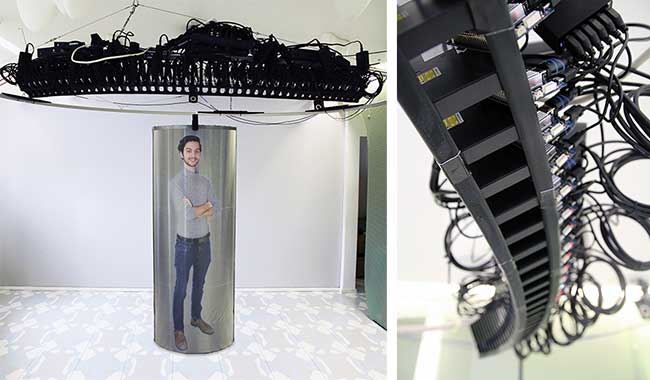Holograms are pretty much everywhere. You can find them in currency, at the doctor’s office, in entertainment, and in smartphone-based augmented reality. Many people may recall rap artist Tupac Shakur’s posthumous holographic “appearance” at the 2012 Coachella Valley Music and Arts Festival. (Technically, Tupac’s image wasn’t a hologram but a two-dimensional video projected on a flat piece of glass, an optical illusion known as Pepper’s ghost.)
Now, a team of researchers from the Human Media Lab (HML) at Queen’s University in Kingston, Ontario, Canada, has upstaged the Pepper’s ghost trick and unveiled a true holographic videoconferencing system.
TeleHuman 2 allows people in different locations to stand face to face — life size and in 3D — as if they were in the same room.

TeleHuman 2 smart projector ring (left). Close-up of a smart projector ring (right). Courtesy of HML.
Using lasers in intelligent pico projectors mounted in a ring above and around a retro-reflective, human-size, cylindrical pod, the HML team has been able to project humans and objects as light fields. The objects appear in 3D as if inside the pod, and multiple users can walk around and view the images from all sides simultaneously, reminiscent of the famed, fictional holodeck of “Star Trek.”
By capturing the remote 3D image with an array of depth cameras, TeleHuman 2 “teleports” live 3D images of a human from one place to another. Users — teleconference attendees — don’t need to wear a headset or 3D glasses because the display projects a light field with many images, one for every degree of angle.
“Face-to-face interaction transfers an immense amount of nonverbal information,” said Roel Vertegaal, director of HML. “This information is lost in online tools, promoting poor online behaviors. Users miss the proxemics, gestures, facial expressions, and eye contact that bring nuance, emotional connotation, and, ultimately, empathy to a conversation.”
Vertegaal told Photonics Media that TeleHuman 2 injects these missing elements into long-distance conversations with a realism that cannot be achieved with Skype or FaceTime.
“We are building different kinds of hologram displays for interactive purposes,” he said. “We expect everyone to use these as their primary display once resolution and computing power allows.”
Vertegaal and his team first debuted the TeleHuman technology in 2012, but at that time the device only allowed for a single viewer to see the 3D projection correctly using 3D glasses. With TeleHuman 2, multiple participants are able to see their holographic friend or colleague in full 3D, each from their individual perspective, without glasses.
“There are very few displays in the market capable of rendering the angle of light rays. It has potential beyond professional situations,” said Vertegaal. “Think again of a large music festival, and now imagine a performer capable of appearing simultaneously, as a hologram, on TeleHuman 2 devices throughout the venue — bringing a whole new level of audience intimacy to a stadium performance.”
TeleHuman 2 gives users and spectators the ability to think outside the box, so to speak, bringing remote participation a little bit closer to reality.